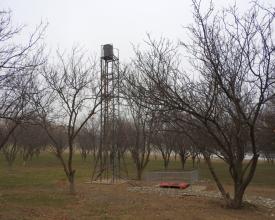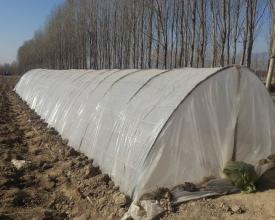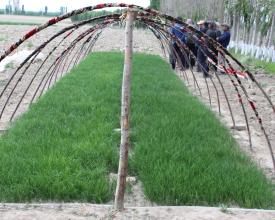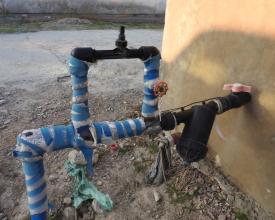
Agricultura integrada en tierras de regadío para adaptarse al cambio climático
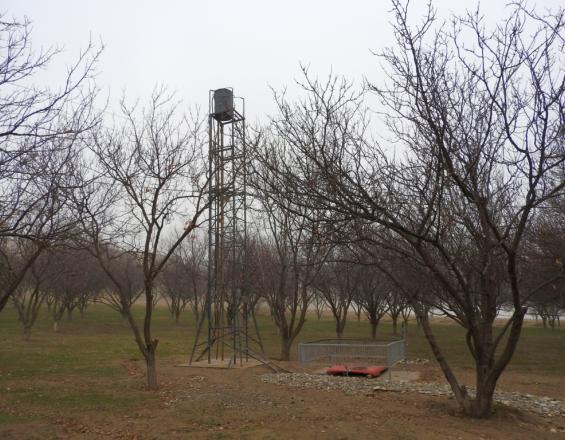
El cultivo de regadío de cebollas, patatas, maíz y otros cultivos se ve obstaculizado por unas prácticas agrícolas deficientes, y estos retos se ven cada vez más agravados por el impacto del cambio climático. Los efectos de las tendencias y predicciones ya visibles provocan una reducción del agua de riego disponible, mientras que el aumento de las temperaturas y la expansión de la agricultura de regadío provocan una mayor demanda de agua de riego. La agricultura de regadío actual tiene una baja eficiencia en el uso del agua de riego.
La solución aborda estos problemas de forma integrada, combinando varios elementos a través de un servicio de extensión agraria:
- El servicio de extensión agraria proporciona asesoramiento adaptado;
- Los servicios de extensión proporcionan insumos agrícolas adaptados en forma de préstamo parcial para facilitar la aplicación del asesoramiento técnico y reducir los costes de transacción de los agricultores;
- Asistencia tecnológica en forma de sembradoras, tecnologías de cultivo e irrigación;
- La diversificación de cultivos tiene en cuenta el cambio climático y la demanda del mercado.
Contexto
Défis à relever
Para la mayoría de los agricultores, los elevados costes de los insumos no son asequibles en el momento en que los necesitan. Los préstamos comerciales no están disponibles o no son asequibles. Por lo tanto, se necesitan préstamos en mejores condiciones que los típicos préstamos comerciales. El servicio de extensión agraria correspondiente concede estos préstamos.
Ubicación
Procesar
Resumen del proceso
Los componentes básicos se integran en cada explotación de forma específica. El servicio de extensión agraria es fundamental para reunir los componentes y ofrecer a cada agricultor la solución que mejor se adapte a sus condiciones, al impacto del cambio climático actual y previsto, a la situación económica de la explotación y a la situación del mercado para los cultivos producidos.
Bloques de construcción
Consulta sobre prácticas e insumos agrícolas
El servicio agrícola proporciona asesoramiento específico a las explotaciones sobre la elección del cultivo y la mejor combinación de semillas (variedades), fertilizantes, pesticidas, tecnología de cultivo y riego. El objetivo de este servicio es proporcionar a los agricultores los mejores conocimientos disponibles para orientar sus decisiones y prácticas.
A veces puede ocurrir que el agrónomo aconseje a los agricultores que apliquen un insumo necesario en un momento determinado, pero los agricultores no sigan este consejo, ya que en ese momento o bien no tienen los medios financieros para comprar los insumos recomendados o bien carecen de acceso a ellos. Así, la prestación de asesoramiento no sería eficaz.
Factores facilitadores
El servicio local de extensión agraria combina una larga experiencia en la región específica con conocimientos sobre las mejores prácticas disponibles a escala internacional. Además, el servicio de extensión colabora estrechamente con los departamentos agrícolas de los respectivos distritos y goza de la confianza de los agricultores. La colaboración con el proyecto de la GIZ permitió integrar nuevas tecnologías de vanguardia.
Lección aprendida
La extensión agraria debe adaptarse a las condiciones específicas de los agricultores locales y todo el asesoramiento debe tener en cuenta sus necesidades y oportunidades, al tiempo que proporciona nuevos conocimientos y sugerencias directamente aplicables.
Paquetes de entrada
Los agricultores, además de recibir el asesoramiento técnico del servicio de extensión agraria, tienen la oportunidad de adquirir directamente los paquetes adecuados de semillas, fertilizantes, pesticidas y otros productos agroquímicos. Como estas compras son necesarias al principio de la temporada de crecimiento, cuando los medios financieros son escasos, se proporcionan en parte (50% de sus costes) en forma de préstamo en condiciones asequibles (tipo de interés inferior a los tipos normales de mercado).
Factores facilitadores
Los factores favorables son:
- Los paquetes de semillas y productos agroquímicos se adaptan a las condiciones de crecimiento locales y todos los componentes son complementarios;
- Los insumos se hacen asequibles en el momento en que se necesitan, pero normalmente los agricultores no pueden permitírselos;
- Los préstamos pueden devolverse cuando los agricultores obtienen ingresos de la cosecha.
Lección aprendida
La combinación de la extensión agraria, que proporciona asesoramiento lateral específico con paquetes de insumos agrícolas a medida, y el mecanismo financiero (parte de préstamo en condiciones asequibles) son fundamentales para la adopción de tecnologías y prácticas agrícolas nuevas y adaptadas. Si faltaran uno o dos de estos elementos, el índice de adopción y aplicación con éxito descendería enormemente. Sin asesoramiento técnico específico, los agricultores no tienen la concienciación ni la capacidad para adquirir combinaciones adecuadas de insumos complementarios. El asesoramiento sin la posibilidad de adquirir directamente los insumos supone una barrera excesiva, ya que los agricultores tienen que buscar proveedores por su cuenta, con los consiguientes costes de oportunidad, y a veces compran combinaciones que no son óptimas o insumos de calidad y cantidad insuficientes. Y sólo la disponibilidad de un préstamo oportuno y asequible permite a los agricultores comprar toda la cantidad de insumos y aplicar las tecnologías adaptadas.
Riego eficaz
La eficiencia del riego puede mejorarse en términos de abastecimiento de agua de riego, distribución y uso a nivel de campo. Se han introducido mejoras específicas para cada lugar, que pueden servir de modelo. Entre ellas figuran
1. 1. Obtención del agua de riego:
- Uso del flujo de agua subsuperficial en cauces secos;
- Uso de la recogida de agua de lluvia de los tejados de las casas para pequeños campos de hortalizas;
- Uso de pozos con baja descarga de agua en combinación con torre de agua y depósito para permitir el riego por goteo de pequeños huertos y campos de melón.
2. 2. Distribución del agua:
- Revestimiento de canales de riego con elevadas pérdidas por infiltración;
- Mejora de las estructuras de desvío de agua para la asignación de cantidades óptimas de agua.
3. 3. Riego eficiente de los cultivos:
- Riego por goteo de diversos cultivos, como cebolla, patata, maíz, melón y manzana;
- Riego por aspersión de la patata.
Factores facilitadores
Los principales factores favorables son la colaboración de diversos agentes: los departamentos de gestión del agua y los departamentos agrícolas de los distritos, las administraciones de los pueblos, los servicios de extensión, las comunidades y los agricultores.
Lección aprendida
El riego por goteo y el riego por aspersión se han probado con éxito en diversos cultivos, pero la viabilidad económica de estas eficientes tecnologías de riego varía. El riego por goteo sólo es económicamente viable cuando los limitados equipos de riego permiten producir un alto rendimiento de cultivos de venta cara, como frutas y melones. Para los cultivos masivos, como la cebolla y la patata, la inversión necesaria es demasiado alta en comparación con los precios que se consiguen por la cosecha. Sin embargo, si el agua de riego escasea más, los equipos de riego se hacen más asequibles y/o los precios de los productos agrícolas aumentan, esta situación puede cambiar y el riego por goteo puede llegar a ser asequible también para estos cultivos.
Hoy en día, el riego por aspersión ya puede ser eficaz cuando el aumento de las temperaturas pone en peligro la productividad y la calidad del cultivo de la patata.
Impactos
Impactos medioambientales:
- Reducción del consumo de agua de riego;
- Mantenimiento y mejora de la fertilidad del suelo.
Impacto social:
- Mayor concienciación sobre el impacto del cambio climático y la relación directa entre la calidad de los insumos y las prácticas agrícolas y el rendimiento y la calidad de las cosechas resultantes;
- Aumento de la confianza, la capacidad y el estatus de los agricultores;
- Aumento de los conocimientos de los servicios de extensión y los departamentos agrícolas implicados;
- Se consolidó la colaboración entre agricultores, servicios de extensión y departamentos agrícolas;
- Se redujo el potencial de conflictos sobre el agua de riego dentro de los pueblos y entre ellos.
Impacto económico:
- Los agricultores pudieron aplicar el asesoramiento técnico del servicio de extensión, ya que los insumos agrícolas se hicieron más accesibles y asequibles;
- La mejora de la eficacia del riego se traduce en "más cosecha por gota" y, por tanto, en una reducción de los costes del agua de riego;
- El aumento del rendimiento y de la calidad de las cosechas estabilizó la seguridad alimentaria;
- Las cantidades y la calidad más fiables de las cosechas permiten un mejor acceso al mercado;
- El aumento de los rendimientos y de la calidad de las cosechas estabilizó la seguridad alimentaria;
- La demanda de insumos mejoró las oportunidades de negocio y empleo de los proveedores de insumos.
Beneficiarios
- Agricultores dedicados a la agricultura de regadío;
- Aldeanos que utilizan el agua de riego para las huertas domésticas y también para las necesidades del hogar;
- Servicio de extensión agraria
Objetivos de Desarrollo Sostenible
Historia
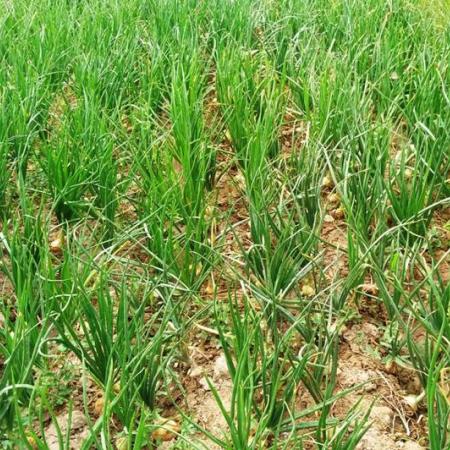
Los agricultores de la región de Sughd dependen en gran medida de los ingresos procedentes del cultivo de cebollas de regadío. Utilizaban semillas disponibles localmente y las sembraban directamente a mano en los campos. Los agricultores no obtenían créditos para la compra de semillas, fertilizantes y persticidas. Así pues, los fertilizantes y los pesticidas apenas eran asequibles y los agricultores tenían escasos conocimientos sobre su aplicación. Como consecuencia, la fertilidad de los préstamos disminuyó, los rendimientos fueron bajos y poco fiables y la calidad de las cebollas cosechadas fue diversa, con un bajo porcentaje de cebollas comercializables a precios óptimos.
El servicio de extensión agraria del OJC Neksigol ayudó a las explotaciones con un paquete de semillas de variedades de cebollas adaptadas a la zona y muy productivas, el abono necesario y pesticidas para los que se dieron instrucciones detalladas sobre su aplicación, dosis y seguridad. Por todos estos insumos la explotación pagaría la mitad del precio en el momento de la compra y la otra mitad tras la recogida de la cosecha. El tipo de interés se situaría en el rango de la diferencia entre el precio a granel, al que el servicio de extensión compró los insumos, y los precios minoristas típicos. Esto es muy inferior a los tipos de interés comerciales típicos. Se proporcionó una sembradora manual especial para utilizar la cantidad adecuada de las costosas semillas. Al propagar las plántulas de cebolla bajo un invernadero de láminas se necesitan muchas menos semillas, agua de riego y productos agroquímicos que con el método convencional de siembra directa en el campo. Y lo más importante: las plántulas de cebolla trasplantadas crecen más rápido y de forma más uniforme.
De este modo, la explotación puede producir mejores cebollas y en mayor cantidad con costes mucho más reducidos. Esto proporciona unos ingresos más seguros y elevados al personal de la explotación.
